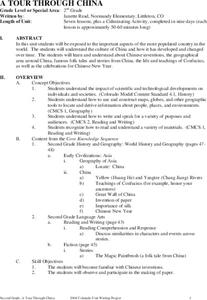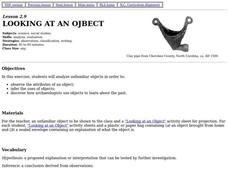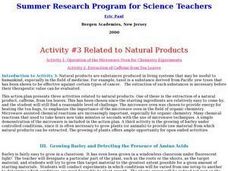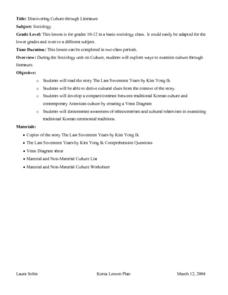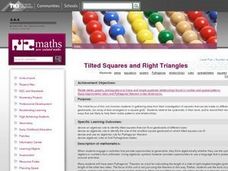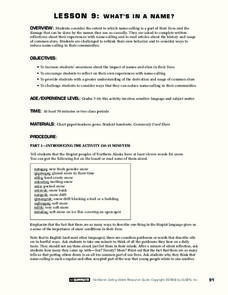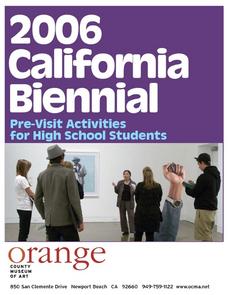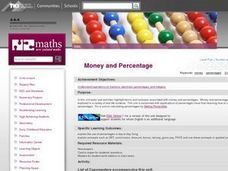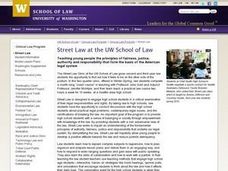Curated OER
Metamorphosis
Young scholars select organic object and transform it to an inorganic object in five or six steps, and complete value rendered drawings.
Curated OER
America the Beautiful
Students analyze the physical geography of the United States and how we have adapted to or altered the land to create the country we know today. Students complete maps with physical features, states and cities of interest.
Curated OER
Dynastic Explorations
Students complete a unit of lessons on medieval Chinese dynasties. They examine the impact the Chinese culture has had on their own lives, label maps, conduct research, read stories, create bamboo stick sentences, write poems, and make...
Curated OER
A Tour Through China
Students explore the culture, development, inventions, and geography of China in the seven lessons of this unit. The teachings of Confucius are examined and the celebrations for the Chinese New Year are inspected.
Curated OER
Traveling Through North America
Students identify places and landmarks in North America, specifically Canada and the United States, by using and constructing maps. Six lessons on one page; includes test.
Curated OER
Looking At An Object
Students observe the attributes of an object, infer their uses, and discover how archaeologists use objects to explore the past.
Curated OER
Growing Barley and Detecting the Presence of Amino Acids
Students produce the greatest mass of plant material possible for 100 seeds of barley, and detect amino acids in barley plant material. They develop rules for the investigation, conduct the experiment, and prepare a computer spreadsheet...
Curated OER
Discovering Culture through Literature
Students read the story "The Last Seventeen Years". Using the story, they identify cultural clues about the country of Korea. In groups, they complete a Venn diagram comparing Korean and United States culture. They use the internet to...
Curated OER
Natural Disaster Acrostic Poems
Fourth graders will conduct research to locate facts about natural disasters. Using a cross-curricular approach they will create acrostic poems with technology. The emphasis will be upon establishing skills for using powerpoint media.
Curated OER
Biodiversity
Students match certain animals with a possible fate that could happen to them from a provided list in order to discover the threats to biodiversity and the role humans play. They also discover the importance of biodiversity and what we...
Curated OER
Taming the Wild Aurochs
Fourth graders assess the development of animal husbandry, outline it in detail as well as arrange the steps in sequential order. In addition, they discuss how certain animals came to be domesticated, concentrate to research on one of...
Curated OER
Reading Graphs
Students plot functions on the Cartesian coordinate plane. They explore lines and parabolas. Students analyze graphs and answer questions about the information presented on the graph using an online program.
Curated OER
Solar Energy - Dehydration
Sixth graders explore process of drying food using solar energy. They cook and/or dry food such as pumpkins, watermelon, corn, and deer meat, explain how solar energy changes foods, and compare and contrast solar energy with other forms...
Curated OER
Tilted Squares and Right Triangles
Students investigate squares. They generate patterns from structured situations and find a rule for the general term and express it using words and symbols. Students generate patterns from a rule and substitute values and formulas.
Curated OER
Denser Sensor
Fourth graders calculate density, compare densities of solids and liquids, measure liquids using a balance, and investigate the significance of density. They conduct an experiment to determine an order of densities, and complete a...
Curated OER
Observation vs. Inference
Student observe two cups, one slightly smaller and skinnier than the other, with one put inside the other. The cups are turned upside-down and the smaller one is caught as it falls out of the larger cup. The larger cup is filled up about...
Curated OER
What's in a Name?
Learners examine how name-calling is a part of their lives and how it affects others. They write reflections of times in their lives when name calling and slurs have been involved. Also, they read articles that discuss the use of slurs...
Curated OER
Discovering Pi
Sixth graders discover Pi. In this discovering Pi lesson, 6th graders measure the diameter and circumference of various circular objects. Students record their measurements in a table. Students discuss how Pi relates to...
Curated OER
Featured Artist
Students investigate the art exhibit known as a biennial. This is an exhibit that occurs every two years. They observe works of the artist before visiting the exhibit in order to create a context for new knowledge that will be covered on...
Curated OER
Money and Percentage
Fifth graders examine use of percentages in real world situations. They complete worksheet about using percentages after reviewing the concept. They look through newspapers to find examples of percentages used over the course of three...
Curated OER
WHERE'S THE BEEF?
The student will become visually aware of the different shapes of wholesale cuts of beef.1. Ask a local meat cutter to make a class visit to explain his or her job. 2. Enlarge the steer outline on Student Worksheet B, and place it on a...
Curated OER
Introduction to the Constitution: The First Three Articles of the Constitution, Separation of Powers
Students review the first three articles of the United States Constitution. In groups, they examine the three branches of government and their function. They follow the path of a bill until it becomes law and discuss Congress' role.
Curated OER
Tree Identification
Students are introduced to the characteristics of trees and different techniques to identify them. They distinguish between a deciduous and a coniferous tree. Students describe at least four characteristics used to identify trees. They...
Curated OER
Roots
Students are introduced to Latin and Greek roots, prefixes, and suffixes. They are given a lesson on ten root words that students identify the correct meaning of the words. Students design cards that are divided into four parts.



